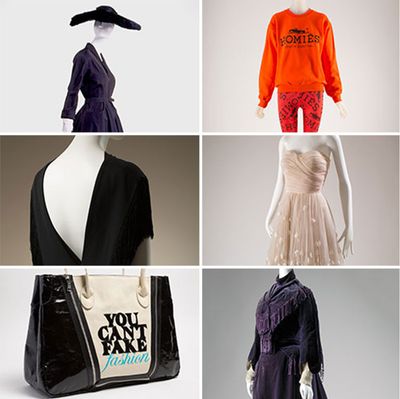
Those who complain about fast-fashion chains knocking off designers often speak of it as a recent phenomenon. But as any fashion-history buff knows, counterfeiting has been happening since long before Zara was a gleam in anyone’s eye. As early as the 18th century, diamond jewelry was imitated with paste; by the early 1900s, American department-store employees were invading Paris Fashion Week and covertly sketching the designs coming down the runway, which they would market as “Paris Originals” but sell cheaply Stateside.
Tomorrow the Museum at FIT will open an entire exhibition — “Faking It: Originals, Copies and Counterfeits” — devoted to the history of counterfeiting fashion. “It’s such a hot topic now, and I think it’s really fascinating for people to realize that both illicit and licit copying was such a big part of fashion for so long,” museum director Valerie Steele told the Cut.
The exhibit — the work of assistant curator of costume and textiles Ariele Elia — features a piece that Steele laughingly calls “an atrociously fake Vionnet.” (Designer Madeleine Vionnet was so terrified of counterfeits that she emblazoned the labels of her designs with her own fingerprint.) Coco Chanel was the polar opposite of Vionnet — she saw the copies as good publicity. “She wasn’t losing clients,” Steele points out. “Those [customers] wouldn’t have been her clients.” Christian Dior was more in the “lockdown” camp, marking his authentic designs with invisible ink that could only be revealed by a black light. Images that were disseminated to publications like Paris Match sometimes blacked out the actual designs. And in 1956, Balenciaga and Givenchy banned the press from seeing their collections for a month in order to deter counterfeiting.
It’s easy to see why the specter of copying was so terrifying to mid-century designers — the copyists’ methods were incredibly crafty. Steele says that noted ‘30s designer Elizabeth Hawkes’s first job in Paris was as a covert sketcher. “They would have people around monitoring to try to make sure they weren’t sketching, and people would bribe workers at the couture houses to smuggle stuff out to them. There was a lot of secrecy about moving clothes between the atelier and [the show venue], with models wrapped in sheets so that you couldn’t see them.” Sometimes they got even sneakier, according to Elia: “They would send in a supposed potential client who was being fitted and she would say, ‘Oh, I would really love to try this on in the comfort of my own home.’ They trusted the client. And she would actually take it to a copy house. They would take apart the dress and copy all the patterns. Or create patterns from it, put it back together, and then the next morning, she would go back to the couture house and say, ‘Actually, I’m not really interested in it anymore.’”
Some houses wised up and authorized licensed copies from the designers themselves — Paul Poiret and the House of Worth were among those who pioneered the practice at the turn of the century. “The poster for the show has a Chanel couture suit from 1966 and a licensed copy, which was probably done for Ohrbach’s,” say Steele. “They are virtually identical, although if you actually touch and handle them you’ll see that they skimped on some things.” She noted that stores “would show the original Chanel with the price tag [reading] $350, and then the Ohrbach’s ‘Chanel,’ $37, side by side in the window.” Sewing patterns were another form of licit copying: “Even someone as complicated as Charles James sold patterns to different companies,” says Steele. (Just imagine trying to DIY your own Charles James original!)
More recent entrants in the exhibit include pieces from Jeremy Scott’s Moschino debut, where he famously referenced fast food, and designer-parody pieces from Brian Lichtenberg (of the Homiès Paris logo) and What About Yves (whose Ghostbusters-themed T-shirt, the subject of a trademark-infringement lawsuit by Chanel, will be on display).
And while copying is not a recent phenomenon, both curators are quick to point out that the line between real and counterfeit is getting thinner and thinner with the proliferation of what are known as “super fakes” — copies so slavishly detailed that it takes an expert to gauge their authenticity. Steele noted that those fakes sometimes even share a provenance with the Real McCoys: “I gather that very often even the same factories will be doing it.”




